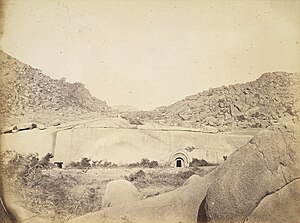Marabar Caves
David Lean, the film's director, supposedly believed the real caves lacked the grandeur he wanted for the scene.
"[17] The main characters Mrs. Moore, Adela Quested, and Dr. Aziz are in a large group that journeys to the Marabar Caves.
During the tour of the caves Adela, Dr. Aziz, and a local guide carry on separately from the group.
Adela privately questions her love for Ronny, a British Civil Magistrate in Chandrapore.
When Adela enters a cave, her claustrophobia, as well as what some critics have assumed is a sexual desire for Aziz, and the consequent guilt over her lack of feeling for Ronny, combine to overwhelm her.
Adela manages to find someone at the bottom of the slopes who helps her to return to Chandrapore where she lodges a charge of molestation against Dr. Aziz.
The caves incident leads to a rift between these characters and Aziz starts believing he has been cheated by Fielding and Adela.
He wants Adela to pay for the troubles she caused but Fielding persuades him to not to harass the poor girl further who made the mistake out of fear and confusion.
[citation needed] The caves remain mysterious and the echo haunts both Mrs Moore and Adela.
The confusion born inside the caves destroys the equilibrium in people's personal lives and relationships.
Marabar Caves and the myths born of them represent a unique side of the Indian culture and how it keeps people within their respective compartments.
Aziz's journey throughout the caves, and his subsequent trial, represent the development of nationalist and pro-independence ideals among the populace of India.
[25] One reviewer takes a Jungian approach, saying that the caves represent the central psychological symbol of the plot.
Though, as the rest of the novel will show, 'nothing has happened' in that dark and echoing place, the force of sexual suggestion is uncompromising.
As only a true writer can, Forster had found his way to a symbolic action richer, more precise than any single concrete occurrence.
[27]A granite and water artwork in Washington DC, created by American architect Elyn Zimmerman, is named Marabar, inspired by the location in the book.
[31] An influential 1980s punk rock band from Northampton England is named The Marabar Caves after the place in the novel.

